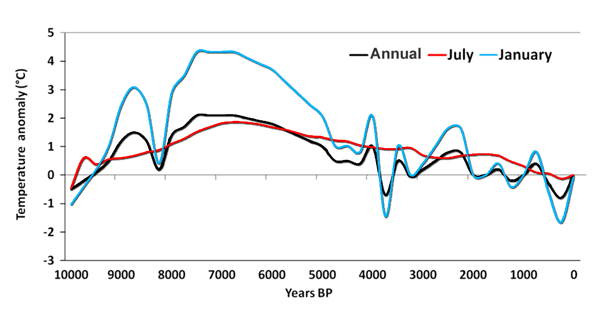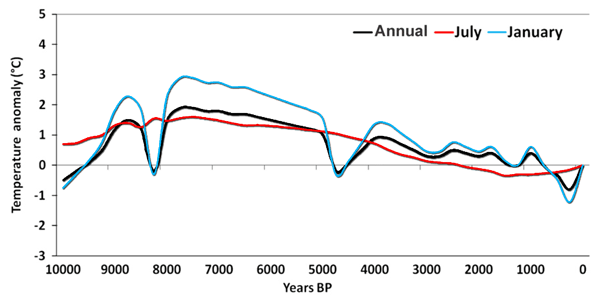Reference
Lilleoren, K.S., Etzelmuller, B., Schuler, T.V., Gisnas, K. and Humlum, O. 2012. The relative age of mountain permafrost - estimation of Holocene permafrost limits in Norway. Global and Planetary Change 92-93: 209-223.
What was done
In the words of the authors, "we reconstructed temperature series of both Northern and Southern Norway based on numerous studies in Scandinavia examining pollen and plant macrofossils in lake sediment cores (e.g. Rosen et al., 2001; Seppa and Birks, 2001, 2002; Davis et al., 2003; Bjune et al., 2004; Nesje et al., 2005; Jensen and Vorren, 2008), chironomids in sediment cores (Rosen et al., 2001; Seppa and Birks, 2001; Korhola et al., 2002), tree line changes (Dahl and Nesje, 1996; Vorren et al., 1999; Seppa et al., 2002), and deposition rate of speleothems (Lauritzen, 1996; Lauritzen and Lundberg, 1999)."
What was learned
The results of Lilleoren et al.'s amalgamating of the many different data sets they employed in their analyses are plotted below for both Northern and Southern Norway.

Figure 1. Anomalies of Northern Norway's mean annual, January and July temperatures over the course of the Holocene relative to 1961-1990. Adapted from Lilleoren et al. (2012).

Figure 2. Anomalies of Southern Norway's mean annual, January and July temperatures over the course of the Holocene relative to 1961-1990. Adapted from Lilleoren et al. (2012).
What it means
In viewing Figures 1 and 2, it should be obvious to one and all that there is nothing unusual, unnatural or unprecedented about present-day temperatures in both Northern and Southern Norway, in contradiction of climate-alarmist claims to the contrary regarding earth's current climatic state. In addition, it can be seen that after the planet finally emerged from the last great period of glaciation, the coldest interval of the current interglacial occurred during the depths of the Little Ice Age, which prevailed just prior to the warming that ushered the planet into its current period of warmth, which is still far less than that of much of the prior part of the record. And as a result of this fact, there would appear to be nothing unusual about the earth warming a good deal more than it already has sometime in the near future, without any need to invoke anthropogenic CO2 emissions as an explanation for the warming.
References
Bejune, A., Birks, H.J.B. and Seppa, H. 2004. Holocene vegetation and climate history on a continental-oceanic transect in northern Fennoscandia based on pollen and plant macrofossils. Boreas 33: 211-223.
Dahl, S.O. and Nesje, A. 1996. A new approach to calculating Holocene winter precipitation by combining glacier equilibrium-line altitudes and pine-tree limits: a case study from Hardangerjokulen, central southern Norway. The Holocene 6: 381-398.
Davis, B.A.S., Brewer, S., Stevenson, A.C. and Guiot,J. 2003. The temperature of Europe during the Holocene reconstructed from pollen data. Quaternary Science Reviews 22: 1701-1716.
Jensen, C. and Vorren, K.D. 2008. Holocene vegetation and climate dynamics of the boreal alpine ecotone of northwestern Fennoscandia. Journal of Quaternary Science 23: 719-743.
Korhola, A., Vasko, K., Toivonen, H.T.T. and Olander, H. 2002. Holocene temperature changes in northern Fennoscandia reconstructed from chironomids using Bayesian modeling. Quaternary Science Reviews 21: 1841-1860.
Lauritzen, S.-E. 1996. Calibration of speleothem stable isotopes against historical records: a Holocene temperature curve for north Norway? In: Climate Change: The Karst Record. Karst Waters Institute, University of Bergen, Bergen, Norway.
Lauritzen, S.-E. and Lundberg, J. 1999. Calibration of the speleothem delta function: an absolute temperature record for the Holocene in northern Norway. The Holocene 9: 659-669.
Nesje, A., Jansen, E., Birks, J.B., Bjune, A., Bakke, J., Andersson, C., Dahl, S.O., Kristensen, D.K., Lauritzen, S.-E., Lie, O., Risebrobakken, B. and Svendsen, J.-I. 2005. Holocene climate variability in the northern north Atlantic region: a review of terrestrial and marine evidence. Geophysical Monograph Series 158: 289-322.
Rosen, P., Segerstrom, U., Eriksson, L., Renberg, I. and Birks, H.J.B. 2001. Holocene climatic change reconstructed from diatoms, chironomids, pollen and near-infrared spectroscopy at an alpine lake (Sjuodjijaure) in northern Sweden. The Holocene 11: 551-562.
Seppa, H. and Birks, H.J.B. 2001. July mean temperature and annual precipitation trends during the Holocene in the Fennoscandian tree-line area: pollen-based climate reconstruction. The Holocene 11: 527-539.
Seppa, H. and Birks, H.J.B. 2002. Holocene climate reconstructions from the Fennoscandian tree-line area based on pollen data from Toskaljavri. Quaternary Research 57: 191-199.
Seppa, H., Nyman, M., Korhola, A. and Weckstrom, J. 2002. Changes of treelines and alpine vegetation in relation to post-glacial climate dynamics in northern Fennoscandia based on pollen and chironomid records. Journal of Quaternary Science 17: 287-301.
Vorren, K.D., Jensen, C. and Alm, T. 1999. Klimautviklingen i Troms og Vesteralen de siste 26,000 ar. Ottar 227: 29-35.
Reviewed 21 November 2012



